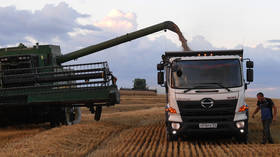Russia records worst harvest in years amid global food crisis

Last year’s grain harvest was the worst in three years, Russian officials have cautioned, as sharp rises in food prices squeeze households across much of Europe.
According to the national statistical agency, Rosstat, the amount of wheat harvested in Russia fell by 12%, or 10 million tons, to 75.9 million tons, while barley production fell 14%, to 18 million tons. Only the corn harvest improved, by 6%, up to 14.6 million tons.
The slim pickings were due to a combination of droughts, the death of winter crops, and a shortage of migrant labor for seasonal work. The US Department of Agriculture had predicted a Russian wheat harvest of 85 million tons at the start of the season but lowered its estimate after several important agricultural regions, including Orenburg and Tatarstan, were struck by bad weather.
According to Kirill Tremasov, director of monetary policy at the Russian Central Bank, farmers’ efforts did not amount to “a very good harvest.” He warned that the country is likely to see food prices continue to increase in 2022 as a result.
The Russian economy saw a sharp rise in inflation in 2021, causing many lower-paid workers to struggle to afford groceries and other basic items. Figures published over the summer showed food prices had gone up 7.4% in the past year, and in an August poll, half of all Russians reported that they had skipped purchasing new shirts and shoes due to a shortage of cash.
A number of other nations across Europe have also had supply issues in recent weeks because of a range of factors, including logistics problems and the Covid-19 pandemic.
Most large grain exporting nations, including Canada, Brazil, and the US, experienced harvest failures in 2021. Ukraine, however, which is vying with Russia for the title of the largest global exporter, saw a bumper crop. It produced over 106 million tons of cereals, legumes, and oilseeds, exceeding its agriculture ministry’s forecast of 100 million. This was thanks in part to the state lending $1.1 billion to farmers in an effort to boost its agricultural sector, which currently accounts for 9% of its GDP.
The National Bank of Ukraine estimated that the harvest will add 0.8% to the national GDP, and it could allow the nation to position itself as the premier global grain exporter. In 2021, the largest importer of Ukrainian agricultural products was China, followed by India and the Netherlands.













